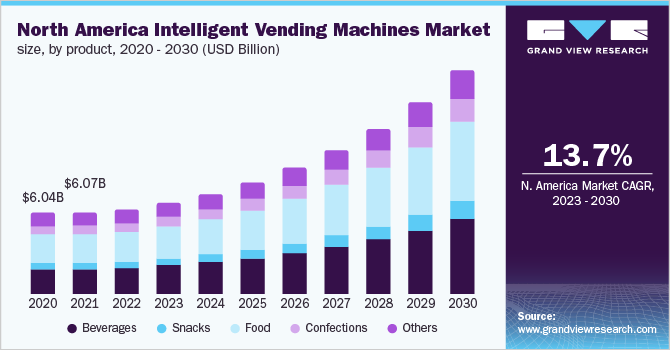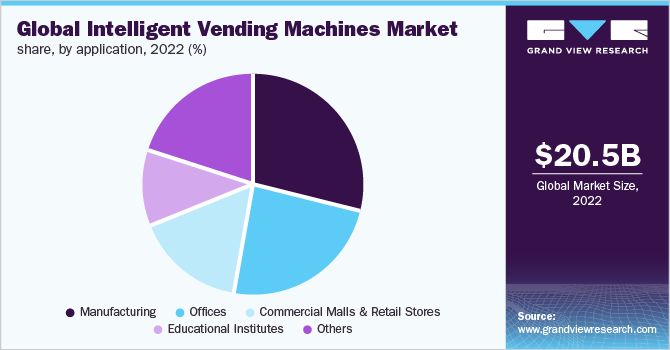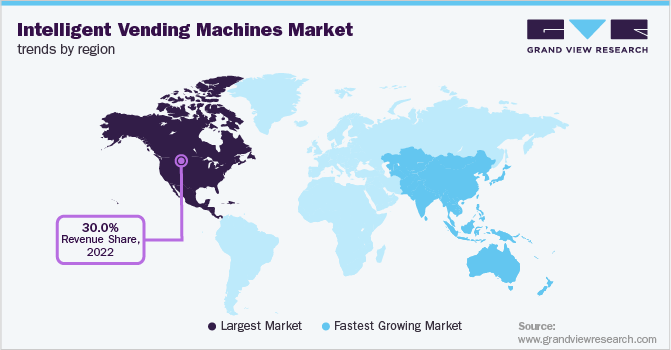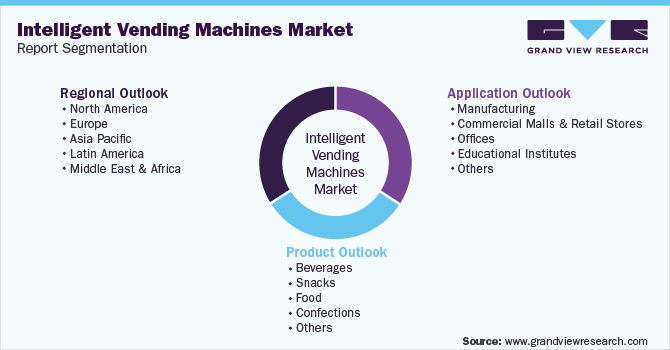- Home
- »
- Next Generation Technologies
- »
-
Global Intelligent Vending Machines Market Size Report, 2030GVR Report cover
![Intelligent Vending Machines Market Size, Share & Trends Report]()
Intelligent Vending Machines Market (2023 - 2030) Size, Share & Trends Analysis Report By Product (Beverages, Snacks, Food), By Application (Commercial Malls & Retail Stores, Offices, Educational Institutes), By Region, And Segment Forecasts
- Report ID: GVR-1-68038-728-5
- Number of Report Pages: 125
- Format: PDF
- Historical Range: 2018 - 2021
- Forecast Period: 2023 - 2030
- Industry: Technology
- Report Summary
- Table of Contents
- Interactive Charts
- Methodology
- Download FREE Sample
-
Download Sample Report
Intelligent Vending Machines Market Summary
The global intelligent vending machines market size was estimated at USD 20,512.5 million in 2022 and is projected to reach USD 55,520.4 million by 2030, growing at a CAGR of 14.0% from 2023 to 2030. In 2020 and until mid-2021, the COVID-19 pandemic negatively impacted the overall market growth due to supply chain disruption and lowered demand from the end-users due to the work-from-home model.
Key Market Trends & Insights
- In terms of region, North America was the largest revenue generating market in 2022.
- Country-wise, Brazil is expected to register the highest CAGR from 2023 to 2030.
- In terms of segment, food (food, candy, ice cream & frozen) accounted for a revenue of USD 7,223.9 million in 2022.
- Snacks is the most lucrative product category segment, registering the fastest growth during the forecast period.
Market Size & Forecast
- 2022 Market Size: USD 20,512.5 Million
- 2030 Projected Market Size: USD 55,520.4 Million
- CAGR (2023-2030): 14.0%
- North America: Largest market in 2022
Nevertheless, as the severity of the virus subsided, several end-use industries were seen returning to the office and eventually increased the demand for the market. Traditional vending machines have a dispensing unit and accept payment in only cash and coins. Whereas intelligent vending machines are enhanced traditional vending machines that are integrated with primary functionalities such as LCD/touchscreen, cashless systems, telemetry systems, voice recognition, digital signage, and enterprise resource planning (ERP) systems, among others.

The growing adoption of the Internet of Things (IoT) and connected device technologies is anticipated to support the expansion of the intelligent vending machines market in the forecasted period. Consumers’ increasing adoption of contactless and cashless payments to make food & beverage purchases is further boosting the market growth. Latest technologies including contactless mobile payments, face & voice recognition, Near-field communication (NFC), telemetry, and government mandates to display nutrition information & product warning are factors expected to impact the intelligent vending machines market positively over the forecast period.
Intelligent vending machines that are embedded with face and voice recognition sensors guide users in product selection by recommending products based on their age and historical buying pattern. Moreover, interactive touchscreen display technology helps vendors to generate more profits by interacting with customers’ smartphones showcasing HD displays running interactive promotions, marketing advertisements, and other third-party information which can be monetized. Furthermore, due to advancements in communication technology, machines can contact vending operators by broadcasting real-time notifications via cloud technology to reduce operational as well as maintenance costs. The IoT technology enables machines to communicate information such as product unavailability, dynamic route optimization, and increasing logistics efficiencies.
However, the strict government regulations for the sale of junk food in public areas such as schools, and universities and the restrictions on the sale of hazardous products, such as tobacco and cigarettes, are estimated to impact the market growth negatively. More, the economic slowdown imposed due to the Covid-19 pandemic and high technology costs is some of the factors deterring operators, from upgrading traditional vending machines.
The lockdown imposed due to COVID-19 impacted the global market significantly. Many organizations changed their operations, from contactless practices to distant working models. These changes in practices created many opportunities as well as restraints for the market growth of intelligent vending machines. Furthermore, an increasing need to avoid a human interaction-based shopping experience gave a further boost to contactless transactions. However, raw material sourcing and the unavailability of vending machine components across the globe was a major concern among intelligent vending machine vendors, owing to the shutdown in business operations. The majority of component manufacturers are based in China and other APAC countries; the supply of machine components was halted due to irregularities in transportation during the lockdown period.
Product Insights
Based on product, the market for intelligent vending machines is categorized into beverages, snacks, food, confections, and others. The snacks category is estimated to emerge as the fastest-growing product sub-segment in the market, owing to the increasing focus on longer working hours, healthy products, and innovative new product launches, among others. The food sub-segment is expected to emerge as the largest segment over the forecast period. The segment mainly comprises food products such as food, candy, ice cream & frozen items that suit healthy lifestyles and needs. The availability of food products in easy-to-carry packaging and multi-layered aseptic cartons is escalating the adoption of food products.
The market demand for food was valued at USD 7.22 billion in 2022 and is predicted to grow at a CAGR of 13.8% over the forecast period. Stringent government regulation to maintain the quality and hygiene of food products is driving the demand from end-use consumers. A significantly high preference among consumers for instant food items and innovative food products is propelling the demand for the food segment.
Application Insights
Based on application, the market for intelligent vending machines is categorized into manufacturing, offices, commercial malls & retail stores, educational institutes, and others. The adoption of intelligent vending machines in areas such as industrial sectors and commercial offices is gaining friction in recent days due to the growing preference and adoption for contactless transactions and ease of use in vending products. Offices are the fastest-growing segment of the market in 2022 growing at a CAGR of 14.8% during the forecast period. The manufacturing sub-segment is the largest sub-segment and is valued was valued at USD 5.88 billion in 2022 and is presumed to grow at a CAGR of 14.6%.

The adoption of these systems at manufacturing facilities offers several benefits, such as space conservation, cost-effectiveness, and cleanliness. Commercial malls and retail stores are estimated to hold a significant share of the intelligent vending market during the forecast period. The segment occupied 16.3% of the total market share in 2022. An increase in daily footfalls and rising awareness of contactless ordering & payments due to the COVID-19 pandemic is expected to increase the demand for intelligent vending machines from commercial malls and retail stores sub-segment over the forecast period.
Regional Insights
The North American region dominated the market with more than 30% revenue share in 2022. The growth can be attributed to, higher usage of mobile payments, developments in communication technologies, and faster internet connectivity, among others. Stringent government regulation in countries such as the U.S. and Canada, promoting energy conservation, is accelerating the deployment of these systems in the region. Intelligent vending machines usually require a lump sum initial investment and incur regular maintenance and operations costs. Organizations operating in the North American region have high spending power and can effortlessly afford to spend on intelligent vending machines further driving the demand in the region.

The Asia Pacific is expected to emerge as the fastest-growing region and is expected to grow at a CAGR of 15.6% during the forecast period. The region is rapidly becoming a major commercial hub center soon surpassing major European countries in the next five years. Increasing spending on infrastructural sectors, rising spending power, adoption of the latest communication technologies, and companies operating from offices post-pandemic are some of the factors driving the market growth.
Key Companies & Market Share Insights
Industry players are increasingly focusing on adopting inorganic growth strategies by acquiring smaller industry participants and other ecosystem players. For instance, in January 2021, France-based Sodexo acquire U.S.-based Accent Food Services, a fast-growing regional convenience services operation. With this acquisition, Sodexo plans to strengthen its takeout, delivery, and convenience store concepts, and multi-channel offerings, including click n' collect, self-service pantries, office refreshments, micro-markets, and smart vending machines. Market participants are further emphasizing collaborating with other players to expand and optimize their market share. Some of the prominent players in the global intelligent vending machines market include:
-
Crane Co.
-
Advantech Co. Ltd.
-
Azkoyen Group
-
FAS International S.p.A.
-
Bianchi Vending Group S.p.A
-
Rhea Vendors Group
-
N&W Global Vending S.p.A.
-
Westomatic Vending Services Ltd.
-
Seaga
-
Jofemar
-
Sanden Corp.
-
Royal Vendors
Intelligent Vending Machines Report Scope
Report Attribute
Details
Market size value in 2023
USD 22.2 billion
Revenue forecast in 2030
USD 55.52 billion
Growth rate
CAGR of 14.0% from 2023 to 2030
Base year for estimation
2022
Actual estimates/Historical data
2018 - 2021
Forecast period
2023 - 2030
Market representation
Revenue in USD billion and CAGR from 2023 to 2030
Segments covered
Product, application, region
Regional scope
North America; Europe; Asia Pacific; Latin America; Middle East & Africa
Country scope
U.S. ; Canada; U.K.; Germany; France; Italy; Spain; Netherlands; Rest of Europe; China; India; Japan; Australia; Rest of Asia Pacific; Brazil, Mexico; Rest of Latin America
Report coverage
Revenue forecast, company share, competitive landscape, growth factors, and trends
Customization scope
Free report customization (equivalent to up to 8 analysts’ working days) with purchase. Addition or alteration to country, regional & segment scope.
Pricing and purchase options
Avail customized purchase options to meet your exact research needs. Explore purchase options.
Global Intelligent Vending Machines Segmentation
This report forecasts revenue growth at global, regional & country levels and provides an analysis of the industry trends in each of the sub-segments from 2018 to 2030. For this study, Grand View Research has segmented the global intelligent vending machines market report based on product, application, and region:

-
Product Outlook (Revenue, USD Billion; Volume, Thousand Units; 2018 - 2030)
-
Beverages
-
Snacks
-
Food
-
Confections
-
Others
-
-
Application Outlook (Revenue, USD Billion; Volume, Thousand Units; 2018 - 2030)
-
Manufacturing
-
Commercial Malls & Retail Stores
-
Offices
-
Educational Institutes
-
Others
-
-
Regional Outlook (Revenue, USD Billion; Volume, Thousand Units; 2018 - 2030)
-
North America
-
U.S.
-
Canada
-
-
Europe
-
UK
-
Germany
-
France
-
Italy
-
Spain
-
Netherlands
-
Rest of Europe
-
-
Asia Pacific
-
China
-
Japan
-
India
-
Australia
-
Rest of Asia Pacific
-
-
Latin America
-
Brazil
-
Mexico
-
Rest of Latin America
-
-
Middle East & Africa (MEA)
-
Frequently Asked Questions About This Report
b. The global intelligent vending machines market size was estimated at USD 20.5 billion in 2022 and is expected to reach USD 22.2 billion in 2023.
b. The global intelligent vending machines market is expected to grow at a compound annual growth rate of 14.0% from 2023 to 2030 to reach USD 55.52 billion by 2030.
b. North America dominated the intelligent vending machines market with a share of 30.5% in 2022 This can be attributed to the rapid adoption of self-service technology and the emergence of new business models. Favorable mandates in countries such as the U.S. and Canada, promoting energy conservation, are accelerating the deployment of these systems in the region.
b. Some key players operating in the intelligent vending machines market include Crane Co., Advantech Co. Ltd., Bianchi Vending Group S.p. A, Azkoyen Group, FAS International S.p.A., N&W Global Vending S.p.A., Rhea Vendors Group, Westomatic Vending Services Ltd., Sanden Corp., Seaga, Jofemar, and Royal Vendors.
b. Key factors that are driving the intelligent vending machines market growth include increasing penetration of Internet of Things (IoT) and connected device technologies, coupled with rising inclination of consumers toward cashless payments.
Share this report with your colleague or friend.
Need a Tailored Report?
Customize this report to your needs — add regions, segments, or data points, with 20% free customization.

ISO 9001:2015 & 27001:2022 Certified
We are GDPR and CCPA compliant! Your transaction & personal information is safe and secure. For more details, please read our privacy policy.
Trusted market insights - try a free sample
See how our reports are structured and why industry leaders rely on Grand View Research. Get a free sample or ask us to tailor this report to your needs.










